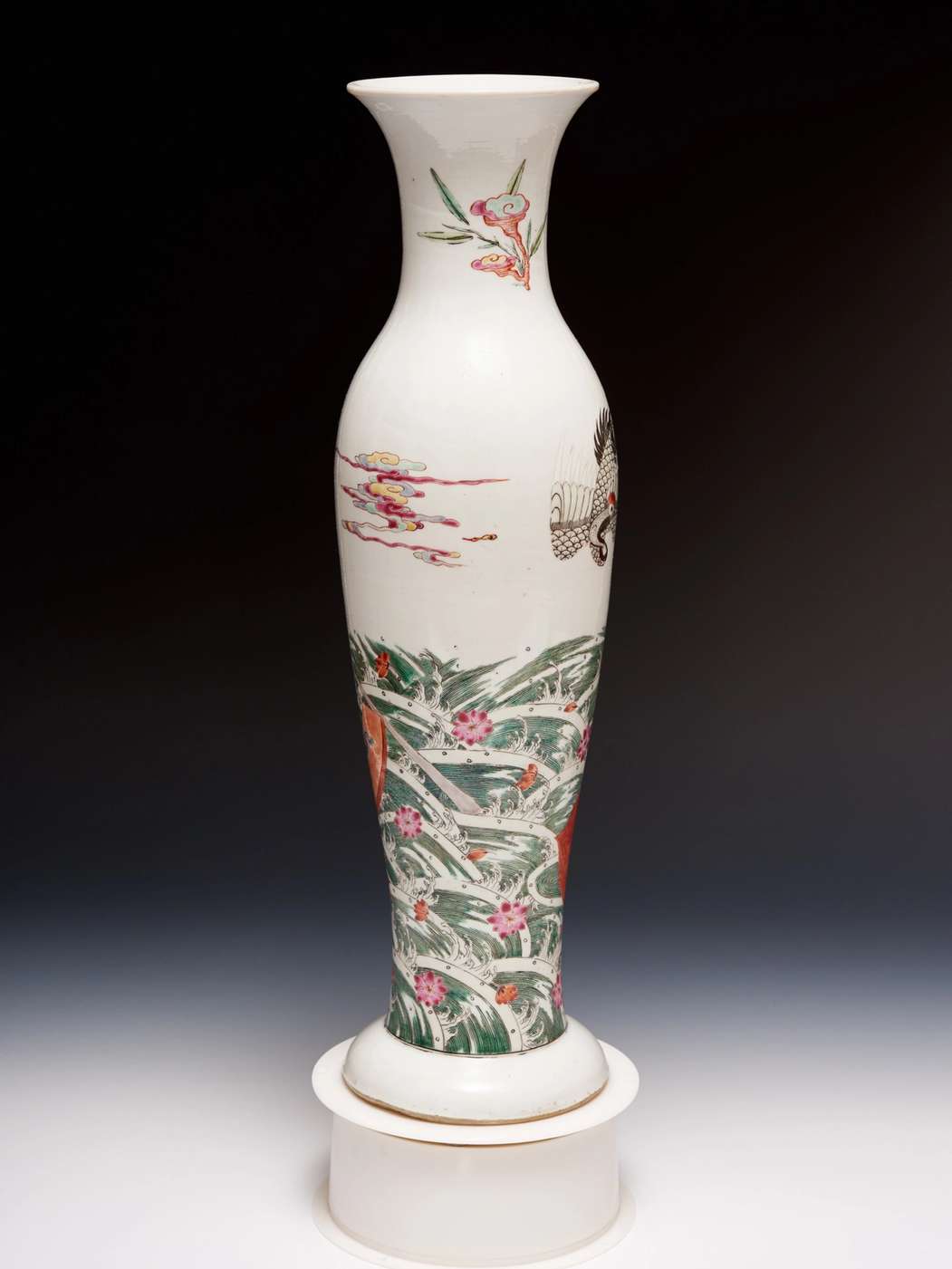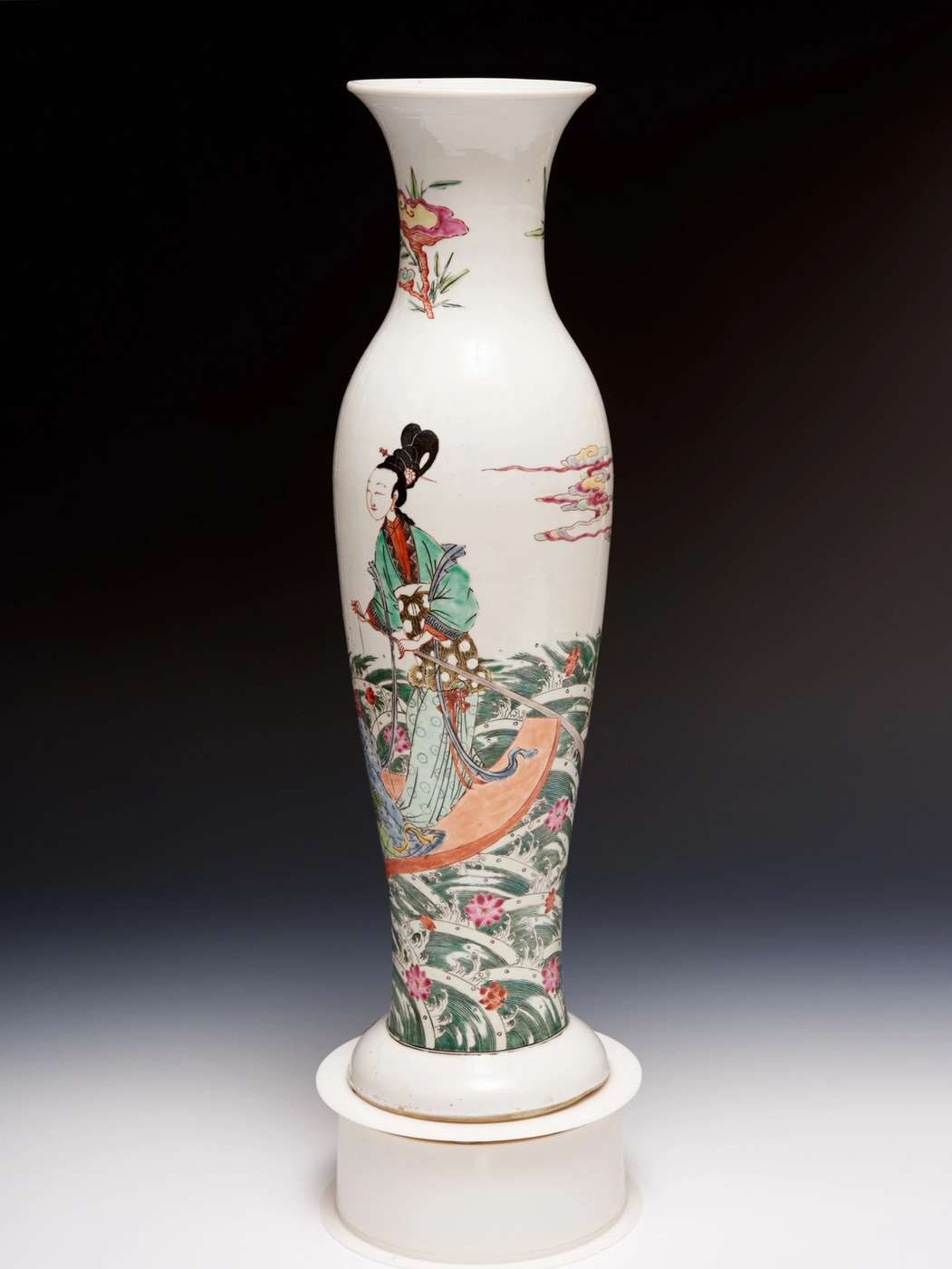Click the above image to zoom
Chinese porcelain vase decorated in famille rose (fencai) enamels with Xiwangmu, Yongzheng.
Stock Number: 3653
Very fine and rare Chinese porcelain tall vase decorated in rich and delicate famille rose (fencai) palette enamels with the goddess Xiwangmu “Queen Mother of the West” in her peach form boat with a crane above her head, c. 1730, Yongzheng reign, Qing dynasty, h. 45 cm,17½ in. 3.4093
Illustrated: 100 Years of Chinese Export Porcelain, by A. Varela Santos, 2014/2015, cat. 56.
For similar pieces:
• Gulbenkian Museum, Lisbon, Portugal, for a similar vase and two others of the same shape, pp. 162-167;
• Edward J. Farmer Collection, New York, Sotheby’s London, 20th November 1936, lot 43;
• Oriental Ceramic Art, by S.W. Bushell, 1896 New York reprint of 1980, fig. 257.
For pieces with the same form:
• Chinesisches Porzellan, by E. Zimmermann, 1923 Leipzig, p. 29;
• Chinese Porcelain and Hard Stones, by E. & J.F. Gorer, plate 190;
• Chinese Art, Victoria and Albert Museum, London, by S.W. Bushell, vol. 2, fig. 58;
• Oriental Ceramic Art, W. T. Walters Collection, by S.W. Bushell, fig. 257;
• Collection of Old Chinese Porcelain formed by Richard Bennett, Esq, Thorney Hall, Northampton, London, cat. 325 for a similar vase with different decoration;
• Qing Porcelain: Famille Verte, Famille Rose, by M. Beurdeley and G. Raindre, London 1987, p. 90 for a drawing of a similar vase;
• Qing Porcelain: Famille Verte, Famille Rose, by M. Beurdeley and G. Raindre, London 1987, plate 138 for a similar vase;
• A Connoisseur’s Guide to Chinese Ceramics, by C. and M. Beurdeley, London 1984, p. 232, plate 89 and p. 254, cat. 131 for a similar vase.
◆ This rather unusual form was manufactured only during the late Kangxi and Yongzheng reigns.
Xiwangmu is the Daoist Chinese goddess of immortality, often referred to as the Queen or Royal Mother of the West and rules over the western paradise of the immortals. Very early stories described her as a terrifying tiger-woman who brought the plague, but under the influence of Taoism she became a benign goddess. Later stories have her as the wife of the Jade Emperor.
She is said to live in a nine storey palace of jade in the mythical Kunlun Mountains, near the Lake of Jewels. It is surrounded by a wall over a thousand miles long and constructed of pure gold. The male immortals live in the right wing and the female immortals in the left wing of this palace. In her garden she cultivates the peach of immortality. This peach tree creates only one peach every three thousand years, which then takes another three thousand years to ripen. When it is ripe, Xi Wang Mu invites the immortals to a feast to celebrate their birthday and to share the miraculous peach which bestows another lease of immortality.
Xiwangmu is the only deity in the entire Chinese pantheon with the ability to talk directly to humans and exclusively to Chinese emperors in order to give them the Mandate of Heaven and teach them the secrets of immortality.
In most of her interactions with the earthly kings, Xiwangmu took on the role of a Taoist master. Though Xiwangmu would do her best to teach them her secrets to immortality, the emperors would always fail her tests and remain mortal.
Xiwangmu is a very popular deity, especially among Taoists. Because Xiwangmu holds power over health and fertility, celebrating her holiday (which falls on the annual autumn equinox) is very important.
An especially popular figure amongst women, Xiwangmu is considered to be a mythological feminist icon thanks to her vast powers, wild nature, and strong independent streak.
Cranes, or herons as they are also referred to, play an important role in Chinese mythology. In Chinese culture the crane is venerated as the prince of all feathered creatures and thus as a legendary status. Embodying longevity and peace it is the second most favoured bird symbol after the phoenix. Throughout the Imperial times crane motifs were used on the robes of civil officials to depict their rank. Because of its ability to fly high and over long distances its wings were used as an amulet for protection against exhaustion.
非常精美且稀有的粉彩高花瓶,繪有西王母御蟠而行,頂上有鶴,約1730年,清雍正,高45厘米17½英寸。
插圖:《百年中國外銷瓷》 阿.瓦瑞拉.桑托斯,2014/2015年出版,編號81。
類似器物:
• 葡萄牙里斯本的古爾本基安博物館,有一個類似的花瓶以及兩個相同形狀的花瓶,第162-167頁;
• Edward J. Farmer藏品,紐約,蘇富比倫敦,1936年11月20日,編號43;
• 《東方陶瓷藝術》,作者S.W. Bushell,1896年紐約出版,1980年第2次印刷,參見圖257;
器型相同:
• 《中國瓷器》,作者E. Zimmermann,1923年萊比錫出版,參見第29頁;
• 《中國瓷器和硬石》,第190頁,作者E. & J.F. Gorer,參見圖頁190;
• 《倫敦維多利亞和阿爾伯特博物館的中國藝術》,作者S.W. Bushell,參見卷二圖58;
• 《東方陶瓷藝術》,作者S.W. Bushell,參見圖257;
• 《中國古代瓷器收藏》,作者Richard Bennett, Esq.,倫敦北安普敦Thornby Hall出版,參見編號325一紋飾不同的類似花瓶;
• 《清代陶瓷:素三彩及粉彩》,作者M. Beurdeley及G. Raindre,1987年倫敦出版,參見第90頁繪有一類似花瓶。
• 《清代陶瓷:素三彩及粉彩》,作者M. Beurdeley及G. Raindre,1987年倫敦出版,參見第138頁一類似花瓶。
• 《中國陶瓷鑑賞家指南》,作者C. Beurdeley 及 M. Beurdeley,1984年倫敦出版,參見第232圖頁89及第254頁,編號131一類似花瓶。
◆ 這種器型相當罕見,僅在康熙晚期和雍正統治時期製造。西王母是道教至高無上的女神,民間俗稱「王母娘娘」、「瑤池金母」等。早期西王母以豹尾虎齒的半人半獸形象出現,帶來疾病與災禍。在道教的推崇下,她被塑造成善良的女仙,民間故事將其玉皇大帝和西王母配成夫妻。據傳,西王母居崑崙之間,有城千里,玉樓十二。據說西王母居住在一個用美玉雕琢而成的晶瑩剔透的九重宮殿裡,宮殿外有蜿蜒一千米的金色城牆,男神們住在宮殿的右翼,左翼居住的是美麗的仙女和女神。
在她的花園裡,她種植了有長生不老效用的桃子,三千年開花,三千年結果。相傳三月三日為西王母誕辰,當天西王母會大開盛會,並以蟠桃為主食,宴請眾仙,讓神仙長生不老,此即蟠桃會。
西王母是唯一能夠直接與人類以及中國皇帝交談的神靈,以賦予他們天命,並教給他們永生的秘密。
在西王母與皇帝的大部分往來中,她擔任道家大師。儘管西王母會竭盡所能向他們傳授不朽的秘密,但皇帝們總是無法通過她的考驗因而保持凡軀。
西王母是一個非常受歡迎的神靈,尤其受道教推祟。由於西王母掌控著健康和生育能力,因此每年每年秋分的祭祀非常重要。
西王母在女性中特別受歡迎,由於她擁有強大力量,天性自由而獨立,所以被認為是神話中的女權主義偶像。
在中國神話中,鶴或蒼鷺也起著重要的作用。鶴被認為有君子之風,比喻具有高尚品德的賢能之士,因地位超然。鶴象徵長壽與和平,是僅次於鳳凰的第二受歡迎的鳥類象徵。在整個帝制時期,官員的官服上都使用鶴圖案來描繪其職級。由於其能夠高飛和長距離飛行,其翼被用作護身符,以防疲憊。




